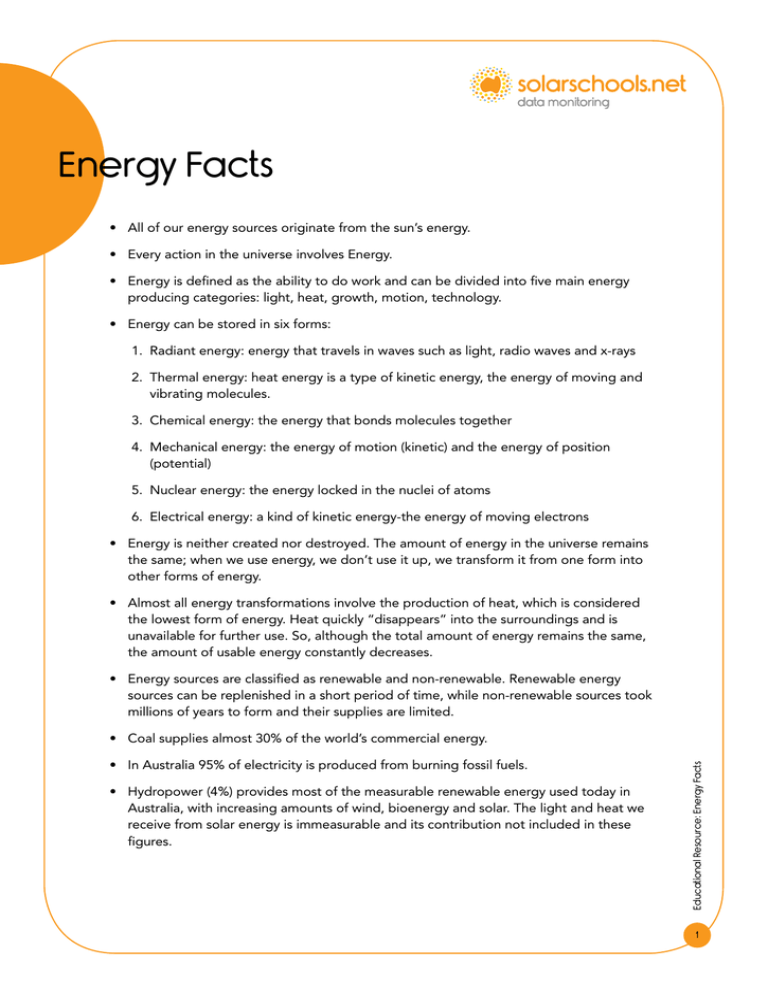Educational Resource: Energy Facts
advertisement

Energy Facts • All of our energy sources originate from the sun’s energy. • Every action in the universe involves Energy. • Energy is defined as the ability to do work and can be divided into five main energy producing categories: light, heat, growth, motion, technology. • Energy can be stored in six forms: 1. Radiant energy: energy that travels in waves such as light, radio waves and x-rays 2. Thermal energy: heat energy is a type of kinetic energy, the energy of moving and vibrating molecules. 3. Chemical energy: the energy that bonds molecules together 4. Mechanical energy: the energy of motion (kinetic) and the energy of position (potential) 5. Nuclear energy: the energy locked in the nuclei of atoms 6. Electrical energy: a kind of kinetic energy-the energy of moving electrons • Energy is neither created nor destroyed. The amount of energy in the universe remains the same; when we use energy, we don’t use it up, we transform it from one form into other forms of energy. • Almost all energy transformations involve the production of heat, which is considered the lowest form of energy. Heat quickly “disappears” into the surroundings and is unavailable for further use. So, although the total amount of energy remains the same, the amount of usable energy constantly decreases. • Energy sources are classified as renewable and non-renewable. Renewable energy sources can be replenished in a short period of time, while non-renewable sources took millions of years to form and their supplies are limited. • In Australia 95% of electricity is produced from burning fossil fuels. • Hydropower (4%) provides most of the measurable renewable energy used today in Australia, with increasing amounts of wind, bioenergy and solar. The light and heat we receive from solar energy is immeasurable and its contribution not included in these figures. Educational Resource: Energy Facts • Coal supplies almost 30% of the world’s commercial energy. 1 • One third of the greenhouse gas emissions in Australia come from fossil fuel electricity generation. • One kilowatt of electricity from coal-fired power stations in Australia produces about one kilogram of greenhouse gases to be released into the atmosphere. • For every kilogram of coal burned three kilograms of greenhouse gases (mostly carbon dioxide) enter the atmosphere. • Australians use approximately four times more energy per person than the world average. • The average Australian family burns about eight kilograms of coal each day in electricity usage. • Some scientists believe that global warming is beginning to warm up our seas - this could be causing rises in sea level, more adverse weather patterns and coral bleaching. • In Australia we may only have enough gas to last another 60 years. • It took millions of years for the Earth to create all the oil on the planet. At the rate we are using it we have less than 50 years supply left in the world and only about 10 years of our own supply left in Australia. • At present, non-renewable energy electricity production is cheaper than renewable, but the cost of solar and other forms of renewable energy is getting cheaper as more people are using it. • In the not too distant future we may not drive petrol driven cars. Find out what you can about solar cars, hydrogen cars and biodiesel. • A home’s water heater, refrigerator and other appliances use almost half of the energy consumed in the home. • Modern appliances such as dishwashers, water heaters, stoves, stereos, and refrigerators need energy to operate-mostly electricity. • Appliances must be properly maintained and operated to maximise energy efficiency and prolong operating life. • The greatest energy expense in the average home is its heating and cooling. • Energy efficient buildings can substantially reduce energy costs. Design features such as orientation, verandahs, window placement, as well as insulation, all help to improve the energy efficiency and comfort of buildings. Educational Resource: Energy Facts • Technological improvements can increase the initial cost of an appliance, but can reduce the life cycle cost. Projected energy costs over the life of an appliance should always be considered when purchasing an appliance. 2 • Insulation reduces heating and cooling energy costs. • The generation and distribution of electricity is one the most significant technological achievements of the last century. Electricity is a necessity of an industrialised society. • Electricity is an energy carrier. It is an economical, efficient, and convenient way to move energy and must be produced from other forms of energy. • The major sources of energy used to generate electricity in Australia are coal, natural gas, and hydropower. • A significant amount of the nation’s energy is used to generate electricity. Electricity’s percentage of total energy consumption is expected to increase in the future. • Electricity is measured by the kilowatt-hour. Educational Resource: Energy Facts • Conventional power plants convert about one-third of the fuel source’s energy into electricity; the other two-thirds is converted into heat. 3




